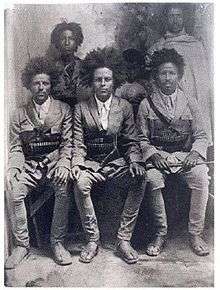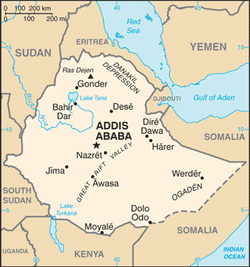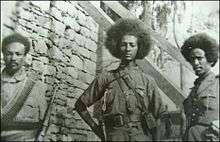Arbegnoch

The Arbegnoch (Amharic, "Patriots") were Ethiopian resistance fighters in Italian East Africa from 1936 until 1941. They were known to the Italians as shifta.
Organisation
The Patriot movement was mostly based in the rural Shewa, Gondar and Gojam regions, though it drew support from all over occupied Ethiopia. Several hundred Eritreans also participated.[1] Small cells operated in Addis Ababa and other towns, known as Wust Arbagna (Insider Patriots).[2] The Black Lions took part in the movement.[3] In 1937/1938, there were an estimated 25,000 active Patriots in Ethiopia. The average band of resistance fighters was estimated in 1938 to included 400 to 500 members, depending on the agricultural season.[4]
Christians
The Patriots had the near-total support of the Ethiopian Orthodox Church.[3] The majority of participants were Christian highlanders. Ethiopian Muslims were less involved in the Italo-Ethiopian conflict and sometimes considered the Christians as much their enemies as the Italians. Relations between the two religious groups were tenuous throughout Italian occupation and in one instance Muslim Oromo attacked and killed retreating Patriots in Wollo Province.[5]
Women
A number of women participated in the Patriot movement, many of whom had been raped by Italian soldiers.[6] Ethiopian women fought in combat against the Italians and took on support roles, made possible through organised women's groups. The Ethiopian Women's Voluntary Association, established in 1937, coordinated its members' work against the Italians, many of whom fought alongside the Patriots. Another organization, the Ethiopian Women's Patriotic Union, directly aided regular Patriot forces. As co-conspirators with the Insider Patriots, members provided the resistance with food, medicine, clothing, arms and ammunition and intelligence. During Ethiopia's liberation, many women from the union took up arms. Others acted as lookouts, cleaned weapons on the battlefield or managed first aid stations.[7]
History
Italian invasion

A couple months into the Second Italo-Ethiopian War on 9 December 1935, Ethiopian Minister of War Mulugeta Yeggazu ordered all chiefs in the north to undertake "patriotic resistance against the Italians for taking away the independence of Ethiopia".[8] The Patriot movement only emerged in the spring of 1936 after the Battle of Maychew in the Tigray Region as scattered troops of the Army of the Ethiopian Empire resorted to guerrilla tactics against occupying forces.[9] Local civilians joined in and operated independently near their homes. Early activities included stealing war materials, rolling boulders off cliffs at passing convoys, kidnapping messengers, cutting telephone lines, setting fire to administrative offices and fuel and ammunition dumps and killing collaborators.[10]
As disruption increased, the Italians were forced to deploy more troops to Tigray, away from the campaign further south. The Italians began referring to the Patriots as shifta, which roughly translates from Amharic to English as "bandit"; the word also has a connotation of "one who rebels against an unjust authority" and many freedom fighters reclaimed the label and took pride in its usage.[10] On 4 May, Patriots led by Haile Mariam Mammo ambushed an Italian column in Chacha, near Debre Berhan and killed approximately 170 Askari and took four Italians prisoner, who were later released.[11] Addis Ababa fell to the advancing Italians on 5 May 1936 and the Ethiopians withdrew to nearby areas to regroup; Abebe Aregai went to Ankober, Balcha Safo to Gurage, Zewdu Asfaw to Mulo, Blatta Takale Wolde Hawariat to Limmu and the Kassa brothers (Aberra, Wondosson, and Asfawossen) to Selale. Haile Mariam conducted hit-and-run attacks around the capital.[12] Emperor Haile Selassie fled the country with 117 chests of gold ingots which were used to fund his court in exile and the Patriots' activities.[13]

The emperor left 10,000 troops under the command of Aberra Kassa with orders to continue resistance. On 21 June, Kassa held a meeting with Bishop Abune Petros and several other Patriot leaders at Debre Libanos, about 70 km (43 mi) north of Addis Ababa. Plans were made to storm parts of the occupied capital but a lack of transport and radio equipment made it impossible to mount a coordinated attack. The deposed government in Gore was never able to provide any meaningful leadership to the Patriots or remaining military formations but sporadic resistance was undertaken by independent groups around the capital.[12] On the night 26 June, members of the Black Lions organization destroyed three Italian aircraft in Nekemte and murdered twelve Italian officials, including Air Marshal Vincenzo Magliocco. The Italians had been hoping to gain support in the region by sending the party to talk with the local populace. The viceroy of the newly created Italian East Africa colony, Rodolfo Graziani, ordered the town to be bombed in retaliation for the killing of Magliocco (his deputy). Negative reactions from the locals forced Patriots to depart; Desta Damtew, the commander of the southern Patriots, withdrew his troops to Arbegona. Surrounded by Italian forces, they retreated to Butajira, where they were eventually defeated. A total of 4,000 Patriots are estimated to have been killed in the battles, of whom 1,600, including Damtew, were executed.[15]
Occupation
After the fall of Addis Ababa, Ethiopian resistance was increasingly confined to the mountains and it appeared to most observers that the populace was ready to accept occupation and cooperate with Italian authorities; even the Emperor Selassie was concerned that his compatriots would adjust to Italian rule. But Viceroy Graziani's harsh measures against the Patriots and the general repression that occurred during his tenure eroded support for conciliation.[16] Prince Amedeo, Duke of Aosta was appointed by Mussolini to replace Graziani as Viceroy of Italian East Africa. He was more open-minded than his predecessor and well-suited to encourage the cooperation of the Ethiopian public, but by the time he assumed his responsibilities on 29 December 1937, Ethiopian opinion had soured on the notion of Italian domination.[17] Though most of the original Ethiopian Army had been destroyed, a new resistance network was established in Amhara by aristocrats that had escaped persecution in Addis Ababa and Orthodox clergymen who were disturbed by the Italian overtures to the Muslim population.[18]
A rebellion was initiated in September 1937 in the Lasta region and in a few days was threatening the surprised Italian administration in Begemder and Gojjam. Well-armed Patriots seized numerous outlying residences and destroyed several entire Askari detachments. A number of Italian officers were also killed. Following the insurgency the Italian press ceased to report on combat operations in Ethiopia.[19]
In June 1938 Italian forces encircled Ankober and the surrounding highlands in an attempt to pacify resistance in the region. Haile Mariam was the only Patriot leader who decided to try and effect a breakout and with 500 men he assaulted the Italians in a futile attempt to breach their cordon. He was mortally wounded on 6 June[20] during a major clash at Gorfo, Bulga district.[11] On 2 December 1940, a Patriot force under Admique Besha raided the Italian garrison at Addis Alem. Seventy-eight Italian soldiers were killed and over 2,000 rifles were captured, along with several grenades and artillery pieces.[21]
References
- ↑ Abbink, De Bruijn & Van Walraven 2003, p. 101.
- ↑ Phillips & Carillet 2006, p. 37.
- 1 2 Abbink, De Bruijn & Van Walraven 2003, p. 98.
- ↑ Iliffe 2005, p. 199.
- ↑ Abbink 1998, p. 117.
- ↑ Shillington 2012, p. 382.
- ↑ Milkias 2011, p. 229.
- ↑ Abbink, De Bruijn & Van Walraven 2003, p. 96.
- ↑ Abbink, De Bruijn & Van Walraven 2003, p. 94.
- 1 2 Abbink, De Bruijn & Van Walraven 2003, p. 95.
- 1 2 Akyeampong & Gates 2012, p. 543.
- 1 2 Abbink, De Bruijn & Van Walraven 2003, p. 97.
- ↑ Del Boca 1969, p. 203.
- ↑ Forgacs 2014, p. 133.
- ↑ Abbink, De Bruijn & Van Walraven 2003, p. 102.
- ↑ Del Boca 1969, p. 240.
- ↑ Del Boca 1969, p. 239.
- ↑ Del Boca 1969, p. 241.
- ↑ Del Boca 1969, pp. 241–242.
- ↑ Mockler 2003, p. 190.
- ↑ Forgacs 2014, pp. 133–135.
Sources
- Abbink, Gerrit Jan; De Bruijn, Mirjam; Van Walraven, Klass, eds. (2003). Rethinking Resistance: Revolt and Violence in African History. African Dynamics. II (illus. ed.). Brill. ISBN 978-90-04-12624-4.
- Abbink, Jon (December 1998). "An Historical-anthropological Approach to Islam in Ethiopia: Issues of Identity and Politics" (PDF). Journal of African Cultural Studies. XI (2). ISSN 1469-9346.
- Akyeampong, Emmanuel Kwaku; Gates, Henry Louis, eds. (2012). Dictionary of African Biography. II. Oxford University Press USA. ISBN 978-0-19-538207-5.
- Del Boca, Angelo (1969). The Ethiopian war 1935-1941 (translated ed.). Chicago: The University of Chicago Press. ISBN 9780226142173.
- Forgacs, David (2014). Italy's Margins: Social Exclusion and Nation Formation since 1861. Cambridge Social and Cultural Histories. XX (illus. ed.). Cambridge University Press. ISBN 978-1-107-05217-8.
- Iliffe, John (2005). Honour in African History (illustrated ed.). Cambridge University Press. ISBN 9780521546850.
- Milkias, Paulos (2011). Ethiopia. Nations in Focus. ABC-CLIO. ISBN 978-1-59884-258-6.
- Mockler, Anthony (2003). Haile Selassie's War (illustrated, reprint ed.). Signal Books. ISBN 9781902669533.
- Phillips, Matt; Carillet, Jean-Bernard (2006). Ethiopia & Eritrea (illus. ed.). Lonely Planet. ISBN 978-1-74104-436-2.
- Shillington, Kevin (2012). History of Africa (3rd, rev. ed.). Palgrave Macmillan. ISBN 978-1-137-00333-1.
Further reading
- Marcus, Harold G. (1994). A History of Ethiopia (illus. ed.). University of California Press. ISBN 978-0-520-08121-5.
- Pearce, Jeff (2017). Prevail: The Inspiring Story of Ethiopia's Victory over Mussolini's Invasion 1935–1941. New York: Sky Horse. ISBN 978-1-62914-528-0. Retrieved 4 March 2018.